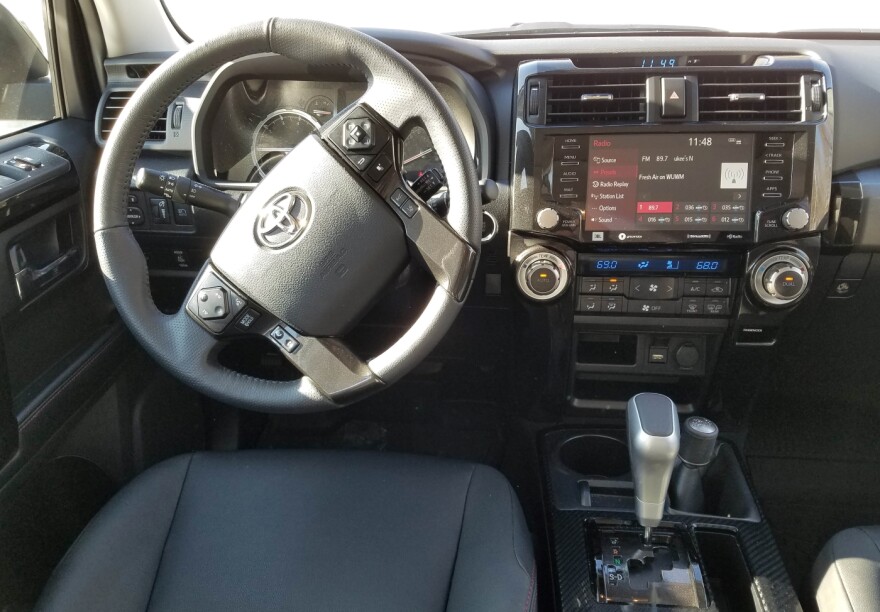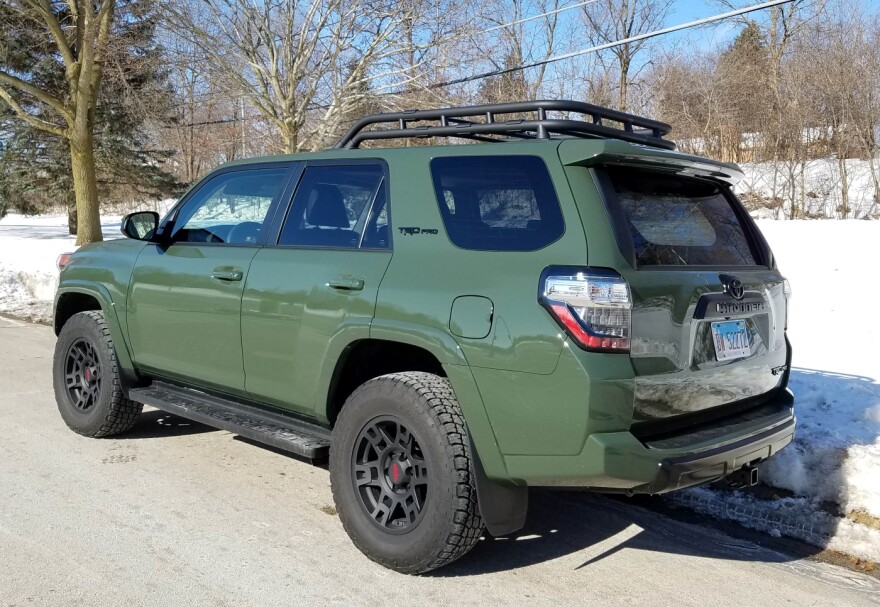My wife calls Toyota’s 4Runner a manly man’s truck, and it certainly is.
Tall, muscular looking, big tires and wheels, a hood scoop, a husky luggage rack on the roof and an engine that growls along with knobby tires that rumble on the road. Yes, manly and a serious off-roader, made even more so by being the TRD Pro edition.
That’s the top of eight trim levels for 4Runner and adds that gnarly hood scoop, the chunky tires and skid plates beneath so you can scrape along craggy rock-strewn trails, and a raised suspension with fancy Fox shocks so maybe you won’t scrape on much. Inside the seats are water resistant and for the audiophiles who want to bash and dash in the outback, a 15-speaker JBL sound system, plus navigation.
READ: 2020 Jeep Wrangler Unlimited Sahara 4x4 Review
The price for going all in on your 4Runner, a body-on-frame truck that exudes toughness, is rather steep, like the hills you can climb with this beast. My TRD Pro, decked out in Army Green, went for $51,968, so just a bit beyond its base price (with delivery) of $50,885. Not many options were added because most everything you’d want, including 4-wheel-drive, comes standard on the TRD Pro.
In fact, the $345 running boards are the only option the truck had that I’d definitely include, mainly because the boards made it easier to climb aboard and reach that big standard cargo rack atop the roof. 4Runner sits pretty tall on its own and boasts 9.6 inches of ground clearance. Not many SUVs have that kind of clearance, unless they’re meant for hitting the trail Conestoga style.

In keeping with its adventurous image and intent, 4Runner has oodles of storage space behind the second row of seats and if you fold those down the cargo area grows to 88.8 cubic feet, plus a bit of extra storage room under the cargo floor. This one added a sliding cargo deck for $350. That might be worth it for shorter folks so they can retrieve bags and such that creep into the deep recesses of the deep cargo bed.
And the rest of the interior is roomy. Plenty of elbow room in the back seat for three adult passengers. Legroom and headroom are generous too.
If you’ve seen or driven a 4Runner in the last eight to 10 years, you know what you’re getting here since not much has changed functionally. The exterior looks tough and masculine and the powerplant remains Toyota’s strong 4.0-liter V6 that churns a hefty 270 horsepower with similar torque rating.
But be forewarned that the engine growls loudly upon acceleration, possibly because Toyota has not yet updated the truck’s old 5-speed automatic transmission. That also hurts gas mileage, which was among the lowest ratings I’ve seen in ages. I got just 14 mpg in my weeklong test and that was below the EPA estimates of 16 mpg city and 19 mpg highway. About 80% of my drives were in town. I should note too that tire noise on the road also is an issue, but minor compared with the engine rumble.

Yet if you’re after strong truck power, 4Runner is a good fit. It will tow 5,000 pounds, so you could easily hitch a boat or a snowmobile trailer behind it for outdoorsy fun. This is a truck and it feels like one as you drive it. It’s heavy at 4,750 pounds and that’s one reason the engine sounds like it’s working so hard.
The ride is trucklike too, not as refined as, say a Dodge Durango. Think Jeep Wrangler Unlimited. There are bumps and thumps to be sure, yet nothing painful. Handling is typical truck, although only minor play in the steering wheel, so easy to control on the highway. Body lean is noticeable in tight turns, but I had no problem parking 4Runner in tight parking spots.
Rear-drive is standard and there’s a big floor shifter behind the console-mounted transmission shift lever. The further one back allows you to put the truck into 4-wheel-drive high and low. On the ceiling console there are two other off-roading adjustment knobs, one for setting your crawl speed when climbing rocks and muck, the other for setting the system for various types of off-road conditions such as mud or sand.
One upgrade of note for this latest 4Runner is the inclusion of Toyota’s Safety Sense features. Those include lane departure, a pre-collision system with pedestrian detection, automatic high beams and smart cruise control.

And the truck’s interior is a lot of hard rectangular shapes, but it’s comfortable and easy to figure out. The infotainment screen is now 8-inches and easy to adjust. Plus, it includes Apple CarPlay and Android Auto capability, so you can link in your smartphone.
I liked that I could easily find and program in my favorite radio stations, which made them simple to access while driving.
Other pluses included heated front seats and a fine overhead sunroof and manual shade.
Seats were well shaped for backs, but with flatter bottom cushions. That usually makes for easier in and out along with more comfort on a long road trip. These were powered and covered in black cloth while the dash was a black hard plastic, but with some red stitching added on the doors and seatback faces. Other trim is either gunmetal gray gloss or a fake carbon fiber.
The truck’s steering wheel is a manual tilt/telescope model with an assortment of controls on the hub. Note the TRD logos everywhere inside and out, including on the floor mats.

The big hatch in back is manual and heavy, plus it’s a bit of a stretch for shorter drivers to reach and pull down.
I hate to criticize a car maker for trying a new color but the Army Green on this one is simply unattractive, making this look like either a military vehicle or utility truck. Toyota has used a dull gray for TRD models in the past too. That was too blah, so this is a slight improvement, I guess.
Then there is that price, which seems pretty steep for a midsize SUV that goes stronger on off-roading than luxury. Still, you don’t have to go $50,000-plus to get a 4Runner, the base SR5 lists at $37,240 with rear-drive, but the same powertrain. Four-wheel-drive is an option on the SR5 and Limited trim lines and standard on all TRD models. TRD also offers an optional Kinetic Dynamic Suspension System that allows a driver to disconnect the stabilizer bars for more effective off-roading.
If bashing around off-road is your main requirement of your SUV then 4Runner is one of your best options, as is a Jeep Wrangler Unlimited. If refinement and luxury is more important than old-school looks and feel, then your choices are much broader.
Overview: 2020 Toyota 4Runner TRD Pro
Hits: Muscular styling on a big ute that’ll haul and tow and do serious off-roading, strong engine and roomy inside. Has running boards, heated seats, sunroof, Safety Sense features, big cargo area, easy-to-use screen.
Misses: Poor fuel economy, feels heavy, noisy engine and tires, body lean in turns, unattractive color.
Made In: Japan
Engine: 4.0-liter V6, 270 hp
Transmission: 5-speed automatic
Weight: 4,750 lbs.
Wheelbase: 109.8 in.
Length: 191.3 in.
Cargo: 88.8 cu.ft. (rear seats down)
Tow: 5,000 lbs.
MPG: 16/19, 14.0 (tested)
Base Price: $50,885 (includes delivery)
Invoice: $46,996
Major Options: Sliding rear cargo deck, $350
Running boards, $345
Cargo divider, $149
Door edge guard, $79
Blackout emblem overlays, $160
Test Vehicle: $51,968
Sources: Toyota, Kelley Blue Book
Editor's note: Mark Savage's auto review column, Savage On Wheels, looks at a new vehicle every week and tells consumers what’s good, what’s not so good, and how the vehicle fits into the marketplace.







